Jantar Mantar Jaipur is an astronomical observatory located in Jaipur, Rajasthan. The construction of Jantar Mantar was built by Sawai Jai Singh from 1626 to 1734, it is included in UNESCO’s World Heritage List.
There are fourteen major instruments in this observatory, which are helpful in measuring time, predicting eclipses, knowing the speed and position of a star, knowing the problems of planets in the solar system, etc.
Looking at these machines shows that the people of India had such deep knowledge of complex concepts of mathematics and astronomy.
Jantar Mantar is an astonishing medieval achievement associated with the old palace ‘Chandramahal’ in Jaipur.
The construction of this unequaled observatory is famous worldwide for analyzing and accurately predicting astrological and astronomical events through ancient astronomical instruments and complex mathematical structures.
The founder of Amer, King Sawai Jai Singh (II) started it in 1728 under his personal supervision, which was Was completed in 1734.
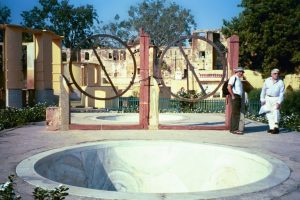 |
| Jantar Mantar Jaipur Rajasthan |
Sawai Jai Singh was also an astrophysicist, whose contribution and personality have been praised by Jawaharlal Nehru in his famous book ‘Discovery of India’ (‘India: a discovery’).
Before the construction of this observatory, Sawai Jai Singh had sent his cultural envoys to many countries of the world, and had asked for manuscripts of ancient and important texts of astronomy from there and preserved them in his pothikhana and got them translated for his study. Maharaja Sawai Jai Singh II built five observatories across the country on the basis of Hindu astronomy.
These observatories were built at Jaipur, Delhi, Ujjain, Benaras, and Mathura. He took the help of eminent astronomers of the time in building these observatories.
First Maharaja Sawai Jai Singh (II) built the emperor Yantra in Ujjain, followed by the Observatory (Jantar Mantar) in Delhi and Jantar Mantar in Jaipur ten years later.
Jaipur observatory is the largest among all the five observatories in the country. Work for the construction of this observatory was started in 1724 and completed in 1734.
It is huge in size with the rest of the Jantar Mantras, it does not match many in terms of crafts and instruments. Of the five observatories built by Sawai Jai Singh, today only Jantar Mantar of Delhi and Jaipur are left, the rest are in the cheek of time.
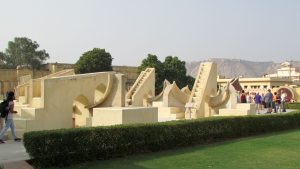 |
| Jantar Mantar Jaipur Rajasthan |
Jaipur’s Jantar Mantar is one of the UNESCO announced on 1 August 2010 to include seven monuments around the world including Jantar-Mantar in the “World Heritage List”.
The observatory has been included in the World Heritage Monument category at the 34th International Conference of the World Heritage Committee in Brasilia, the capital of Brazil.
The main reason behind this honor was counted, the biggest reason was that despite the passing of all the years, all the ancient instruments of this observatory are still in good condition;
Through which astronomical phenomena such as weather, local time, planetary constellations and eclipses, etc.
can be calculated even today. Jantar-Mantar in Jaipur received World Heritage status in 2010. Jantar-Mantar jaipur is the first in Rajasthan and the 23rd cultural heritage of India to include its name in the world heritage. The credit for the construction of a unique heritage of history goes to Maharaja Sawai Jai Singh II.
The monument has been included in the World Heritage List 282 years ago, considering the ‘amazing’ Indian learning of celestial phenomena through instruments made of wood, lime, stone, and metal.
On the basis of the calculation of these instruments, even today the local almanac of Jaipur is published and every year, Ashada Purnima, astronomers predict the rainfall from the ‘wind perception’ process.
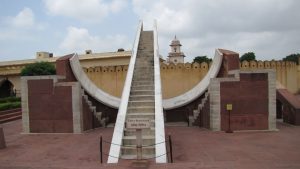 |
| Jantar Mantar Jaipur Rajasthan |
Among the instruments here, ‘Samrat-yantra’ (which is a huge solarium), ‘Jayaprakash-yantra’ and ‘Rama-yantra’ are the most famous, of which ‘Samrat-yantra’ is the highest (about 90 feet from the earth). , Through which time can be told with sufficient accuracy.
Major instruments stationary in Jantar Mantar Jaipur
Elevation machine
Just to the left of the entrance of Jantar Mantar, a huge circular circle of metal hanging between two pillars on either side of a circular platform is known as Unnantham Yantra. This instrument was used to measure the elevation and angular height of the object in the sky.
Detector mural
To the east of the Unnatansh Yantra is Dakshodat Bhatiyantra, a walled building extending from the north to south ends. In the front part, there are steps on both sides from the middle of the wall which leads to the upper part of the wall.
While the back of the wall is flat. This device was used to know the advancement of the sun and the sun revolution and daylight etc. during the middle time.
Direction machine
It is a simple device. In the Jantar Mantar Campus, a large square plane in the middle has a huge circle made of red stone and a right cross is made in all four directions from the center. It is a direction machine that gives knowledge of directions in general.
Monarch machine
The largest Yantra in Jantar Mantar is Samrat Yantra. Due to its grandeur and vastness, it was called Samrat Yantra. The grandeur of the device is gauged from the fact that its top height is 90 feet from the ground. The emperor also has an umbrella at the top. This Yantra was established for revolution, equinox, and time knowledge of planetary constellations.
Rest machine
The Shanthas Yantra is a part of the Samrat Yantra. This annular device is located in the shape of the moon in the east and west directions from the base of the emperor. This Yantra was also used to know the position and degrees of planets and constellations.
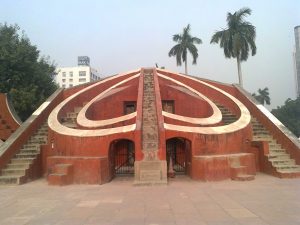
Jayaprakash Yantra ‘A’ and Jayaprakash Yantra ‘B’
Jai Prakash instruments were invented by Maharaja Jai Singh himself. The shape of these bowl-shaped instruments is unmatched. These instruments are located between the Samrat Yantra and Disha Yantra in the Jantar Mantar complex.
In these, the astronomical orientation of half the astrophysics was considered as the horizon and for the knowledge of every substance. Also, the location of the Sun in any zodiac sign is also known by these instruments. These two instruments are complementary.
Umbilical cord machine
This device is located on the right side of the entrance. It is divided into two circular faces. The position of the sun and local time can be accurately estimated from the various lines shown around it from its focal point.
Pole plate
Dhruvdarsha is a simple device used to know the position and direction of Dhruva stars. The wall is facing north to south direction, this plate is raised from south to north respectively. By looking at its southern tip, the position of the polaroid at the northern end is clear.
Mini monarch machine
The Miniature Monarch Yantra is a device located to the west of the Dhruv audience plate. It is also called the sunshine clock. Local time is accurately calculated with this device. This Yantra made of red stone is only a short form of the Samrat Yantra, hence it is known as a miniature instrument.
Zodiac ring machine
Their number is 12 indicating 12 zodiac signs. The special feature of these twelve instruments, showing the location of each zodiac sign and the planetary constellations in them, is their design.
All these instruments are similar in view, but the design of these instruments is different, indicating the position of the zodiac signs in the sky.
Cycle machine
These instruments, made of two huge circles of iron, used to measure the magnitudes of the celestial bodies and the geographical directors of the instantaneous. It is located to the north of the zodiac instruments.
Enter fees Jantar Mantar Jaipur
INR 200 For foreign
INR 50 for Indian
Visiting Time Of Jantar Mantar Jaipur
Visiting time 9:00 AM to 5:00 PM
Visit Duration 30-45 Minutes
How to reach Jantar Mantar Jaipur

My self Dev Satish. I’m an Author and Founder of tourism-rajasthan.com. I’m from Rajasthan and If I talk about my Education then I’m Law Graduate. I love doing work that makes me happy, that’s why I love traveling. you will find Rajasthan travel ideas & tips on this blog.
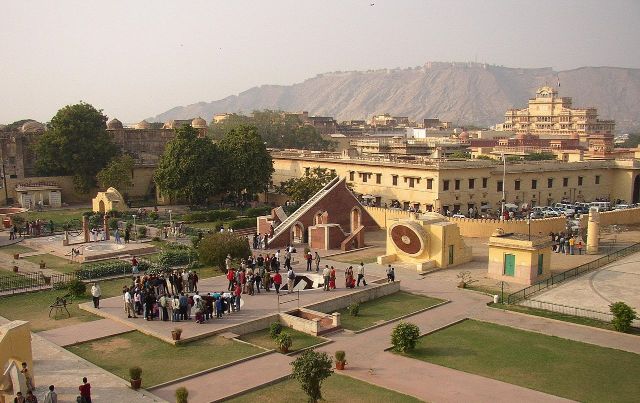
Beautiful Blog post ❤️❤️
Great Information keep it up.
Wonderful Post. Good you explained everything in detail it has been a great help. Thanks for sharing the Useful and Informative Blog. Thanks a lot for sharing so much. I would love to visit this amazing place.
Great post! Thank you so much for sharing it. This article is really amazing, thank you for sharing helpful article. very interesting and amazing details you provide. Excellent Explanation with Wonderful Images. I’ll definitely visit those places one Day.